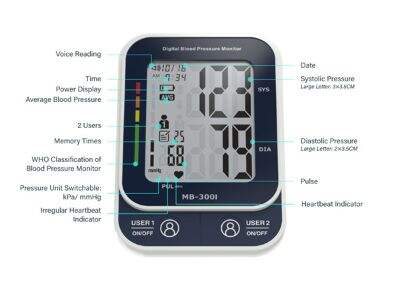Portable electronic blood pressure (BP) monitors have turned out to be very useful tools by which we check our own health at home. But did you know the temperature of where you are can alter the numbers those devices display? The electronic parts inside the BP monitor may react differently when the air is either too hot or too cold. This can make the readings higher or lower than your actual blood pressure. If you are particularly cold, your blood vessels in the arm can constrict, which can alter how sensitive a monitor is to your pulse. Conversely, if it is too warm, your blood vessels can expand and that also affects the measurement. So Hangzhou Huaan, a firm with extensive experience in producing industrial electronics, ensures its digital bp monitor function properly even when the temperature fluctuates significantly. Knowing how temperature can have an impact on your readings allows you to get the proper information about your health.
How to get accurate readings from BP monitor in different ambient temperatures?
Obtaining an accurate blood pressure reading can be difficult when the room or outdoor temperature is not exactly perfect. When you take a reading with a BP monitor, whether it’s the Hangzhou Huaan or any other model, it helps to be relaxing in your environment while you use it. For instance, if you’ve just come inside on a cold day or from exercising and want to check your blood pressure, allow yourself a few minutes. Your body doesn’t react perfectly on Day 1, and if they get the numbers wrong it will miss important information. Also, the monitor itself should be kept somewhere where the temperature doesn’t fluctuate dramatically — it shouldn’t go from very warm to very cold. Consider placing it near a window where the sun is shining all day — it may warm up the device and affect the way it works. Another tip is to not use the monitor in rooms that are heavily air-conditioned or with heaters blowing directly at you, as that can cool or warm your arm rapidly. If the monitor, in particular, is too cold, the batteries inside it may not be functioning well and you will end up with inaccurate numbers. In the case of Hangzhou Huaan bp monitor machine, you can be sure they have been tested to operate in wide temperature ranges but still every little bit counts. If you want to get the right results, attempt to measure your blood pressure in the same room each time, and at the same temperature. That way your readings are a little more consistent, and you can better track your health.
Where to Get BP Machine Online for Varying Temperature Areas?
If you live in locales where the water changes temperature constantly, then it’s crucial that your blood pressure monitor is able to withstand extremes. Hangzhou Huaan provides digital BP monitors of durable material and intelligent technology that work well even in the cold winter or hot summer. These monitors include special components that prevent readings from being altered too significantly by changes in temperature. For instance, some use sensors that recalibrate when the temperature changes, so you get numbers you can believe. If shopping for a blood pressure monitoring machine, look for one that says it works across wide temperature ranges, from very cold (below freezing) to quite warm. Hangzhou Huaan’s devices typically include this kind of data, so you know they are designed to do well in the real world, not just lab rooms. You can purchase these monitors at medical supply stores, online retailers or through Hangzhou Huaan’s website directly. Should you be unsure which of their models are most ideal for your home or office, feel free to consult their customer service. They know what temperature can do to your health implements because it is their expert work in electronics manufacturing. Opting for a thermometer made for various weather will help you rest easy that your results won’t be wrong if the air is too hot or too cold. It makes daily health monitoring easy and reliable.
The Effect of Ambient Temperature on The Life and Performance of BP Monitors
Home electro blood pressure (BP) monitors are easy to use and helpful for people to perform their health checks at home. But the temperature near these devices, known as ambient temperature, can affect how well they function and how quickly they wear out. If the air is too hot or too cold, it may lead to problems within the BP monitor. For instance, the small parts inside the monitor can get damaged or worn out more quickly in extremely hot situations. Additionally, heat can cause the batteries stored inside to lose power faster than anticipated and cause the monitor to stop functioning. Conversely, the monitor’s screen and buttons are also not likely to function as they should if it is too cold. Cold can slow the electronic parts, producing readings that are less accurate. Cooling can also harm the batteries, weakening them and diminishing the device’s performance.
An Approach to Maximize Electronic Blood Pressure Monitor Performance in Hot and Cold Temperatures
It is very important to know how to use an electronic blood pressure monitor properly in order to obtain reliable readings. When the temperature around the device is extremely hot or cold, that can lead to errors in the numbers displayed. To reduce the likelihood of this, there are some simple things you can do to use your BP monitor more effectively in varying temperatures. First, make an attempt to store your BP monitor in a room where the temperature is comfortable usually it’s between 59°F and 86°F (15°C and 30°C). And this is good for the device. If you are going to be using the monitor outside or in a very hot or cold location, wait 20-30 minutes after placing it there. This period of waiting gives the monitor a chance to adjust to the temperature, allowing its internal parts to operate as they would in normal conditions.
Table of Contents
- How to get accurate readings from BP monitor in different ambient temperatures?
- Where to Get BP Machine Online for Varying Temperature Areas?
- The Effect of Ambient Temperature on The Life and Performance of BP Monitors
- An Approach to Maximize Electronic Blood Pressure Monitor Performance in Hot and Cold Temperatures








